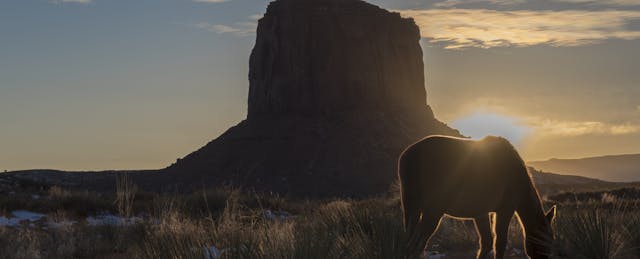Earlier this year, participants of the FIRST world robotics competition garnered national headlines after a team of young girls from Afghanistan were denied visas to attend the event in the United States. While multiple stories of visas kept the competition in the news, an interesting story of firsts from a Navajo team in Utah might have slipped under the radar.
The closest convenience store to Navajo Mountain High School is 35 miles away. The nearest stoplight is 90 miles away. Located on the side of Navajo Mountain, the tiny, isolated school of 35 students surprised themselves and the nation last school year when they made it to the final round of the FIRST robotics international competition.
Fredele Burns, a former student at Navajo Mountain High School, a senior at the time, was the team’s lead driver during the event in April. He never imagined his team would be able to muster the funds to travel across the nation to Houston and compete. Yet his participation in the competition has taken him much further, garnering him a full-ride scholarship through undergraduate and medical school.
“I learned you can create anything out of nothing,” says Burns in an interview with EdSurge. “Most of the things we built our robot with was scrap metal. It was pretty surprising.”
Earlier in the year, Burns’ father lost his job taking care of patients at the senior center on the Navajo reservation, leaving his mom’s work, also in the senior center, as the family’s only steady income. Jobs on the small isolated reservation are hard to come by. With only a senior center, government building, health clinic and school within a 90-mile radius, almost all the families survive on some sort of government subsidy. Others work in coal mines and power plants along the river, making round-trip commutes of about 180-miles each day.
Burns and his teammates used the few resources they had to build a robot when they first entered the competition. During the first round, held in Salt Lake City, the robot was not agile, beautiful or light. In fact, because the school didn’t have a computer-science class, the robot was not even programmed when they first arrived.
“Up to the day of the competition we basically had a big pile of metal and wood that wouldn’t do anything,” says Gary Rock, principal at Navajo Mountain High School. “One of the other schools adopted our school at the competition, and one of their students taught one of our students how to program the computer and the robot. We didn’t score as many points as we could have because we were learning on the spot.”
They did, however, have enough points to advance, moving to the second round in Idaho and then the final international competition in Houston.
But for Burns’ struggling community, qualifying for the competitions was easier than paying for it.
“In the span of two months the team had to come up with $15,000 to $20,000,” Rock explains. “When our teacher-advisor for the group told me that they did really well in Idaho, and they were invited to Houston for the world championships. I had one of those, ‘How in the heck are we going to come up with however much it's going to cost to go to Houston?’ kind of moments. Because I had no clue.”
Rock says his entire staff became involved. As students wrote letters to companies asking for support, some teachers turned to crowdfunding websites such as GoFundMe. What he didn’t expect was the amount of support they received from schools and robotics teams around the nation who sent them thousands of dollars to go to the competition.
“I still don’t know how it happened, but it did,” says Rock between a few chuckles.
Rock says seeing his students take part in the competition has given him a new appreciation for career and technical education opportunities.
That’s something that has always had value in the Navajo community, he says, but almost slipped away during the heavy emphasis on testing after No Child Left Behind policies took effect. He is also thankful for the doors that have opened for his students because of their exposure to the event. The press coverage they have garnered from participating has led small business owners and university officials outside the small reservation to reach out to them.
“When they went to Salt Lake, Fredele was able to visit the University of Utah Medical School, and through this competition,“ Rock says, hesitating as his voice cracks a little. “I just get choked up every time I tell this. He is a really good student, and because of his exposure to the competition, he has a four-year full-ride scholarship to the University of Utah. If he does well, through his bachelor's degree, they will continue funding him all the way through school. He can become a doctor for free.”


